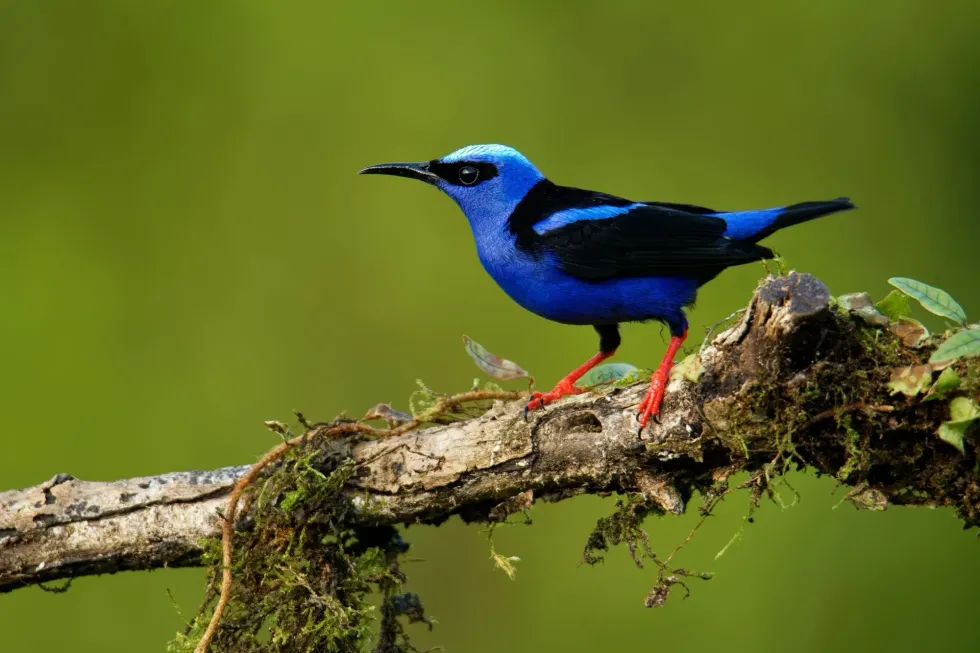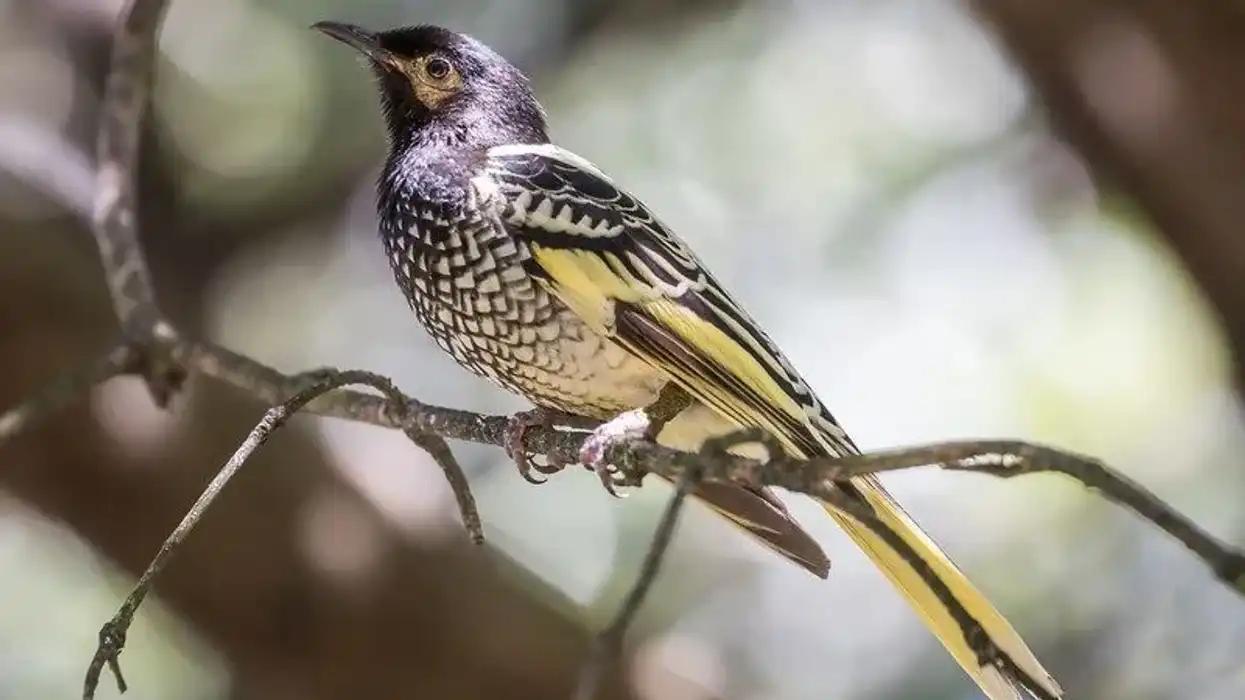Birds from the order Passeriformes are called oscines. Wondering what an 0scine means?
It is the vernacular name for the songbird. It is derived from the Latin word 'oscen' meaning 'a songbird'.
The red-legged honeycreeper, Cyanerpes cyaneus (Linnaeus,1766), is a member of the passerine group of birds. The bird has 11 different subspecies recorded including C. c. carneipes, C. c. pacificus, C. c. gigas, C. c. gemmeus, C. c. eximius, C. c. tobagensis, C. c. cyaneus, C. c. dispar, C. c. violaceus, C. c. brevipes, and C. c. holti.
Formerly described as the black and blue creeper, it was in 1766 that it was listed under its binomial name Certhia cyaneus.
In 1899, the genus Cyanerpes was introduced by an American ornithologist. The species was placed under the genus Cyanerpes followed by a specific epithet 'Cyaneus' having a Latin origin meaning 'dark-blue'.
The bird portrays sexual dimorphism as the male and female species are very different as they have varying plumage, bill, tail, legs, wings, and flight feathers. The birds have brightly colored plumage.
While adult female birds and non-breeding males have a green plumage, the male has a black and violet-blue plumage during its breeding season.
The male bird also has bright red legs and a turquoise-colored crown, while the red-legged honeycreeper juvenile is similar to the female red-legged honeycreeper with a greenish plumage.
These birds range from southern Mexico to Peru, Bolivia, central Brazil, Trinidad, Tobago, extending to Ecuador and Cuba. The species range throughout South America, it is listed as Least Concern under the IUCN Red List of Threatened Species.
If the uniqueness of the red-legged honeycreeper makes you interested to read more about similar species, you can read about blue jay facts and eastern kingbird facts.
Red-Legged Honeycreeper Interesting Facts
What type of animal is a red-legged honeycreeper?
The red-legged honeycreeper, Cyanerpes cyaneus, is a black and blue creeper in the tanager family, Thraupidae. It is a songbird inhabiting the tropical states of America including Brazil, Bolivia, Cuba, Ecuador, Peru, Mexico, Texas, Trinidad, and Tobago. While it has 11 subspecies named, it has several vernacular names like guit-guit saï in French, mielero zamperosse in Italian.
What class of animal does a red-legged honeycreeper belong to?
The red-legged honeycreeper, Cyanerpes cyaneus (Linnaeus, 1766), belongs to the kingdom Animalia, phylum Chordata, class Aves, order Passeriformes, family Thraupidae, and genus Cyanerpes.
How many red-legged honeycreepers are there in the world?
While the blue-black and green bird is found in small groups around the forest and plantation of South America in central Brazil, Bolivia, southern Mexico, Peru, Cuba, Ecuador, Trinidad, and Tobago, the population range of the bird around the world is not quantified.
Where does a red-legged honeycreeper live?
The species of red-legged honeycreeper range around south America from southern Mexico extending as far as Texas, Cuba, and Ecuador. The 11 recognized subspecies are speculated to be found in a specific region like Cyanerpes cyaneus cyaneus ranging from Trinidad to north Brazil, Cyanerpes cyaneus brevipes reside in central Brazil, Cyanerpes cyaneus tobagensis in Tobago.
What is a red-legged honeycreeper's habitat?
The red-legged honeycreeper habitat range around tropical regions with flowering trees in forest edge, open woodland, citrus plantation, and cocoa plantation. The bird is found in groups feeding upon the nectar of flowers, fruits, and insects and breeding around the flowering trees.
Who do red-legged honeycreepers live with?
The male and female red-legged honeycreeper are bright-colored birds speculated to live in small groups perching on flowering trees as they are gregarious species outside the breeding season. The male and female birds are also found in pairs during the breeding season.
How long does a red-legged honeycreeper live?
While the life span of the birds with bright red legs is not recorded, Gouldian finch is speculated to live for four to five years on average. In comparison, species of honeycreeper have a considerable lifespan.
How do they reproduce?
The breeding and non-breeding species have varying basic and breeding plumage, especially in males. The breeding plumage of males is quite bright to attract their potential mates during the breeding season.
The red-legged honeycreeper female is responsible to build the cup-shaped nest on trees. The cup-shaped nest is made up of slender stems and root fibers with an attached spider web to a branch. The female species lay a couple of eggs in its nest.
While the female incubates the egg, both sexes ensure a healthy diet for the red-legged honeycreeper chick. The chick takes its first flight within the first 14-15 days.
What is their conservation status?
The red-legged honeycreeper, Cyanerpes cyaneus, from the tanager family is listed as Least Concern under the IUCN Red List of Threatened Species.
Red-Legged Honeycreeper Fun Facts
What do red-legged honeycreepers look like?
While males and females have a green plumage, the male red-legged honeycreeper breeding is recorded to have a bright blue-black plumage. The male birds are violet-blue with black wings, a tail, and a bill.
The under-tail and underneath of red-legged honeycreeper wings are bright yellow or lemon. The male birds also have a turquoise crown on the head. The non-breeding male has a green plumage with black wings.
Similarly, the female and the chicks are greenish with streaked underparts. Also, the tail and flight wing are brown in color. While the legs of the female are red-brown, the legs are slightly brown in the chick.
The eyes are brown while the black slender bill is slightly decurved. The bright yellow wings and under-tail are only visible during the flight.

How cute are they?
The red-legged honeycreeper bird has bright blue plumage with black wings and tail which are yellow underneath. The bird is a colorful species with bright red legs and black slender and slightly curved bill.
Moreover, the blue males during the breeding season are a pleasant sight to catch and so are the birds in flight. The bright yellow wings and under-tail are visible in flight only. Moreover, the colorful birds found in groups are a treat to the eyes.
How do they communicate?
While the call sounds like 'tsip' or sharp 'tsui', the song is prolonged 'tsip-tsip-tsip-chaa'. Though the bird belongs to the family of songbirds, the song is not as sweet as that of a nightingale as it is considered the pleasant melodic bird around the world.
How big is a red-legged honeycreeper?
The length of the bird ranges up to 4.8 in (12 cm), it is twice the size of the smallest bird around the world, a bee hummingbird with a maximum length of 2 in (6 cm).
How fast can a red-legged honeycreeper fly?
The speed of the bird is unrecorded, while the red-legged honeycreeper is a pleasant sight to catch in flight.
How much does a red-legged honeycreeper weigh?
The species weigh up to 0.5 oz (14 g).
What are the male and female names of the species?
While the species portray sexual dimorphism, these birds do not have different names highlighting their sex.
What would you call a baby red-legged honeycreeper?
Baby birds are often called chicks, nestlings, fledglings, or hatchings.
What do they eat?
While the diet of an ostrich is quite strange as it is recorded to consume an alarm clock, handkerchief, rope, pencil, and other weird stuff, the diet of the red-legged honeycreeper comprises nectar of flowers, fruits, and insects.
Are they dangerous?
No, the red-legged honeycreeper does not possess any sort of danger. It is recorded as one of the most social species around the world.
Would they make a good pet?
While the birds are peaceful and have a friendly temperament, they make good pets but are advised to be kept free.
Did you know...
Males are more brightly colored than females.
Formerly, it was called a blue and black creeper. Now, it has 11 subspecies recorded so far.
Why is it called a honeycreeper?
Honeycreeper defines bright-colored oscine birds around the world. The honeycreepers mainly feed upon nectar being called sugarbirds also. More specifically, the red-legged honeycreeper is known by the name highlighting its bright red legs. It also has several vernacular names in different languages like guit-guit saï in French.
Is a red-legged honeycreeper a hummingbird?
While the honeycreepers are genealogically related to hummingbirds, the species have quite a few similar characteristics. However, a red-legged honeycreeper cannot be considered a hummingbird.
Here at Kidadl, we have carefully created lots of interesting family-friendly animal facts for everyone to discover! For more relatable content, check out these Hawaiian honeycreeper facts and flycatcher facts for kids.
You can even occupy yourself at home by coloring in one of our free printable bunting bird coloring pages.










